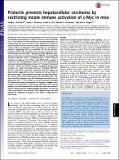Prolactin prevents hepatocellular carcinoma by restricting innate immune activation of c-Myc in mice
Author(s)
Hartwell, Hadley J.; Petrosky, Keiko Y.; Fox, James G.; Horseman, Nelson D.; Rogers, Arlin B.
DownloadHartwell-2014-Prolactin prevents h.pdf (1.454Mb)
PUBLISHER_POLICY
Publisher Policy
Article is made available in accordance with the publisher's policy and may be subject to US copyright law. Please refer to the publisher's site for terms of use.
Terms of use
Metadata
Show full item recordAbstract
Women are more resistant to hepatocellular carcinoma (HCC) than men despite equal exposure to major risk factors, such as hepatitis B or C virus infection. Female resistance is hormone-dependent, as evidenced by the sharp increase in HCC incidence in postmenopausal women who do not take hormone replacement therapy. In rodent models sex-dimorphic HCC phenotypes are pituitary-dependent, suggesting that sex hormones act via the gonadal-hypophyseal axis. We found that the estrogen-responsive pituitary hormone prolactin (PRL), signaling through hepatocyte-predominant short-form prolactin receptors (PRLR-S), constrained TNF receptor-associated factor (TRAF)-dependent innate immune responses invoked by IL-1β, TNF-α, and LPS/Toll-like receptor 4 (TLR4), but not TRIF-dependent poly(I:C)/TLR3. PRL ubiquitinated and accelerated poststimulatory decay of a “trafasome” comprised of IRAK1, TRAF6, and MAP3K proteins, abrogating downstream activation of c-Myc–interacting pathways, including PI3K/AKT, mTORC1, p38 MAPK, and NF-κB. Consistent with this finding, we documented exaggerated male liver responses to immune stimuli in mice and humans. Tumor promotion through, but regulation above, the level of c-Myc was demonstrated by sex-independent HCC eruption in Alb-Myc transgenic mice. PRL deficiency accelerated liver carcinogenesis in Prl[superscript −/−] mice of both sexes. Conversely, pharmacologic PRL mobilization using the dopamine D2 receptor antagonist domperidone prevented HCC in tumor-prone C3H/HeN males. Viewed together, our results demonstrate that PRL constrains tumor-promoting liver inflammation by inhibiting MAP3K-dependent activation of c-Myc at the level of the trafasome. PRL-targeted therapy may hold promise for reducing the burden of liver cancer in high-risk men and women.
Date issued
2014-07Department
Massachusetts Institute of Technology. Department of Biological Engineering; Massachusetts Institute of Technology. Division of Comparative MedicineJournal
Proceedings of the National Academy of Sciences of the United States of America
Publisher
National Academy of Sciences (U.S.)
Citation
Hartwell, H. J., K. Y. Petrosky, J. G. Fox, N. D. Horseman, and A. B. Rogers. “Prolactin Prevents Hepatocellular Carcinoma by Restricting Innate Immune Activation of c-Myc in Mice.” Proceedings of the National Academy of Sciences 111, no. 31 (July 21, 2014): 11455–11460.
Version: Final published version
ISSN
0027-8424
1091-6490